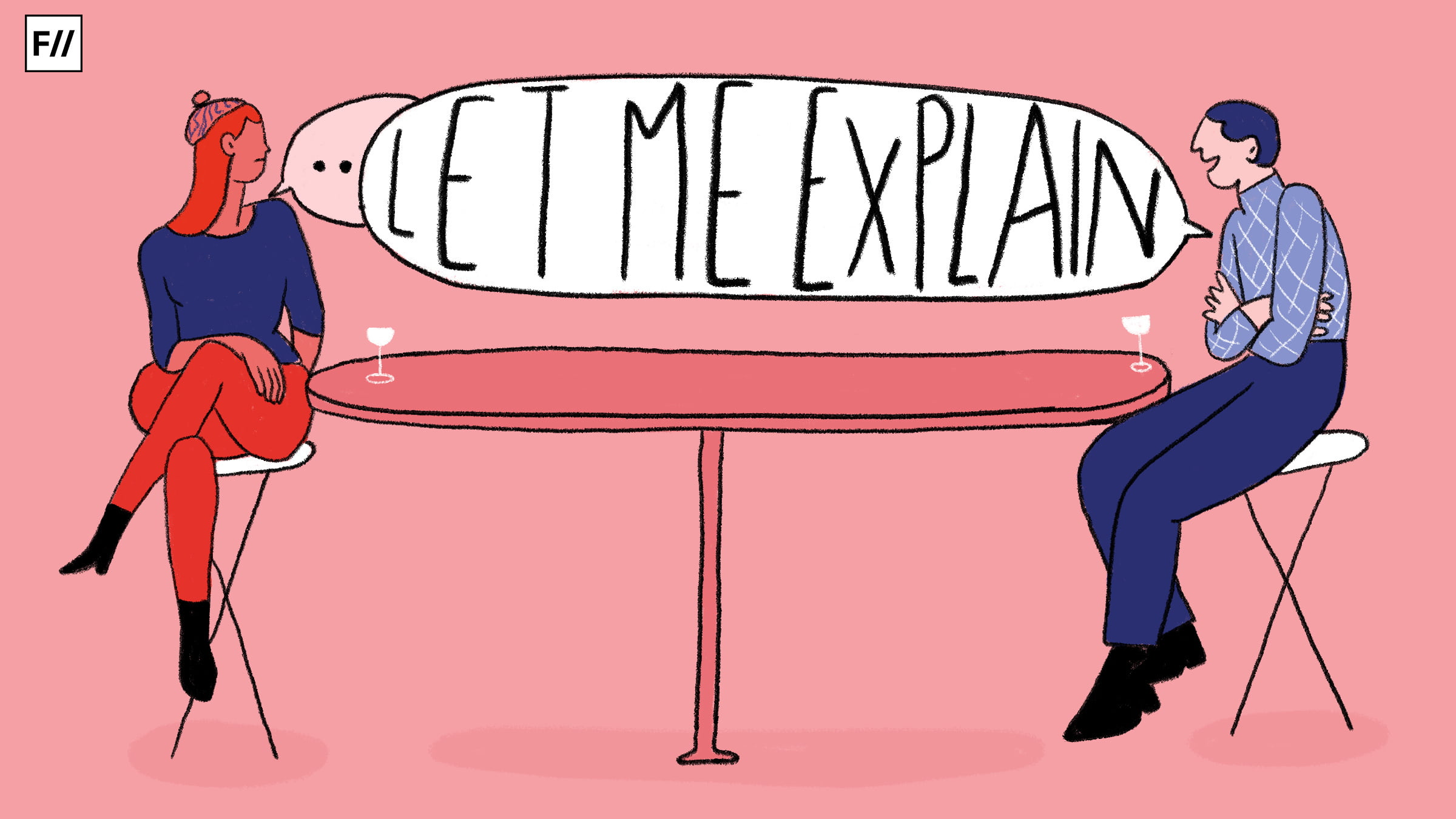He was already telling me about the very important book – with that smug look I know so well in a man holding forth, eyes fixed on the fuzzy far horizon of his own authority.
Rebbeca Solnit in Men Explain Things To Me
It has been nine years since Solnit wrote this legendary essay on the phenomenon now known popularly as mansplaining. She shares an anecdote about a man advising her to read a book, without knowing she is the one who has authored it. The essay throws light on how silencing of female voices is linked to larger abuse of patriarchal power.
While the concept has gained popularity, the fight to end it has been tough and confusing, at least to me. I write this to detangle my thoughts about how I see mansplaining, who are its pioneers and why it threatens the possibility to have enriching conversations.
It is extremely important to identify mansplaining not just as an action, but a reaction. It is a reaction to women’s presence in spaces traditionally dominated by men and their articulation of their own experiences. It stems out of insecurity and sometimes even panic. Information, trivia, anecdotes are used by mansplainers to cancel out women’s knowledge and opinions on various subjects.
Mansplaining is a symptom of two ugly beliefs: that men know better, and that women are always ready to be helped and taught.
Like most reactions, mansplaining is much more visible and bizarre to everyone except the ones who react. For ex: this manel in which Anupama Chopra throws the question on sexism in the comedy industry, these guys react uncontrollably with plenty of mansplaining.
Also read: India’s Female Comedians Are A Badass And Much-Needed Counter To Sexist Humour
Other reactions similar to mansplaining include: aversion to listening to female narratives, manterruption with increased volume, interrogation and demand for statistics on subjective realities, gaslighting through technical and intellectual language and complete dismissal of a woman’s concerns through silence, smug looks, sniggers and no-no nods.
While mansplaining usually refers to men explaining things to women that they might already know, it can manifest in both verbal and non-verbal ways.
It is each and every act that undermines a woman’s abilities to comprehend and negotiate the world around her. When a girl takes two seconds more than the average time in which an average human can open a jar, a guy swoops in, takes the jar from you to open the lid. Without her asking for help at the conference, he jumps to check the connection between the laptop and the projector.
While mansplaining usually refers to men explaining things to women that they might already know, it can manifest in both verbal and non-verbal ways.
Being helped before women even consider asking for it links mansplaining to the general lack of consent in our everyday interactions. It comes from an assumed goodwill and/or out of a power position of ‘knowing’. Mansplaining is a hence a symptom of two ugly beliefs: that men know better, and that women are always ready to be helped and taught.
Many men use age as enough of a reason for them to be explaining things. Since older women and younger men is a rare combination in dating, friendship and office circles, older men typically use those +2 or +5 years to dominate each conversation with their experience of being on earth for a little more time. “When I was your age…“, “In the eighties” become a starting point for every dismissive response to any woman’s concern in the present.
What will conversations between men and women look like if mansplaining is wiped out of them overnight? Awkward silences and confused responses? Unfortunately, most men do not know of other ways to connect with women socially. Ice breaking often means they explain something to us, let’s say how the Indian Postal system works, without pausing to guess that we might know about it already, that we might have looked it up out of our own curiosity or asked a relative who works there.
Being helped before women even consider asking for it links mansplaining to the general lack of consent in our everyday interactions.
This is not one way. I noticed how even I couldn’t maintain certain interactions and friendships once I stopped asking for help or suggestions or advice or rejected it. Without the power to show me light, there was less to explore in the friendship.
Before someone reacts to this with #NotAllMen, let me admit that for once, I believe that too. Not all men mansplain in the same way. There are some who have much more power in the society to do it, often without getting noticed or sometimes even applauded for their benevolent sharing of knowledge. It is also a comment on how savarna women like me, take mansplainers who speak in fluent English and are backed by degrees for national and international universities, more seriously than other men.
It is important to acknowledge that mansplaining is pioneered by savarna men. Historically, it was savarna men who had the right to educate themselves before anyone else did. And historically, they have used this knowledge to dominate, manipulate and gaslight the hell out of our lives. The socio-cultural capital accumulated by them allows them to dominate all parts of society and social movements. With this authority they exercise their power to mansplain and savarnasplain at once without any lived experience of gender and caste discrimination.
Savarna men exercise their power to mansplain and savarnasplain at once without any lived experience of gender and caste discrimination.
To get more specific, I have a thumb rule or a thesis: well-intentioned guys mansplain the most. There are other, outwardly sexist men who are aware (and insecure) that know you know your stuff, who look away or at the watch when you are talking or presenting, and attack you with silence. The classic mansplaining is very often done by the doting fathers, loving partners and woke friends, who are progressive enough to believe in the theory of equality but if one looks carefully, it hasn’t quite seeped in.
Now that we have explored the man part of it, let’s focus on the splaining or explaining bit. Do women explain too? Yes. In fact, multiple times every day. We have been socialized into explaining our whereabouts, schedules and behaviours to seek permissions. We explain what we were doing when men do bad things to us. We explain our existence in private, public, online and offline spaces by listing out valid, respectable reasons.
Also read: Victim Blaming: A Trope As Old As The Hills
This sort of explanation is in stark opposition of the one men are used to. We explain to justify our existence as humans on earth and they explain everything happening on this planet as if we were living on some other. We explain because we feel inferior, they explain because they feel superior.
Are all explanations bad? Are all of them gendered? Will they always lead to a power dynamic between two people? My experience has been complicated. I love how mutual sharing and explaining leads to incredible learning and unlearning.
When we live segregated lives while growing up, it is important to understand different subjectivities (gender, caste, sexuality, capital etc.) on different subjects (career, science, education, sex, emotions, freedoms etc.) once we do converge and interact.
It is NOT mansplaining if a guy is sharing his perspective that comes from a social identity that may or may not as visible as his gender. It is much needed learning and I would never want to lose out on it. It is crucial to realize how everyone oppressed by cis-het savarna men needs to be heard clearly and learnt from.
Most of life is learnt not in schools or through books but in conversations about it. In developing conversations as pedagogy, we need to secure explanations from their gendered versions and value them by building a consensual and respectful environment around them.
I end this monologue how I began it, with a relevant quote from Solnit’s brilliant essay:
Don’t forget that I’ve had a lot more confirmation of my right to think and speak than most women, and I’ve learned that a certain amount of self-doubt is a good tool for correcting, understanding, listening, and progressing—though too much is paralyzing and total self-confidence produces arrogant idiots. There’s a happy medium between these poles to which the genders have been pushed, a warm equatorial belt of give and take where we should all meet.
Rebecca Solnit
Rajashree loves to write, learn, laugh and also assist children in doing the same. She blogs here.





So very well written.. please come with more topics like this.